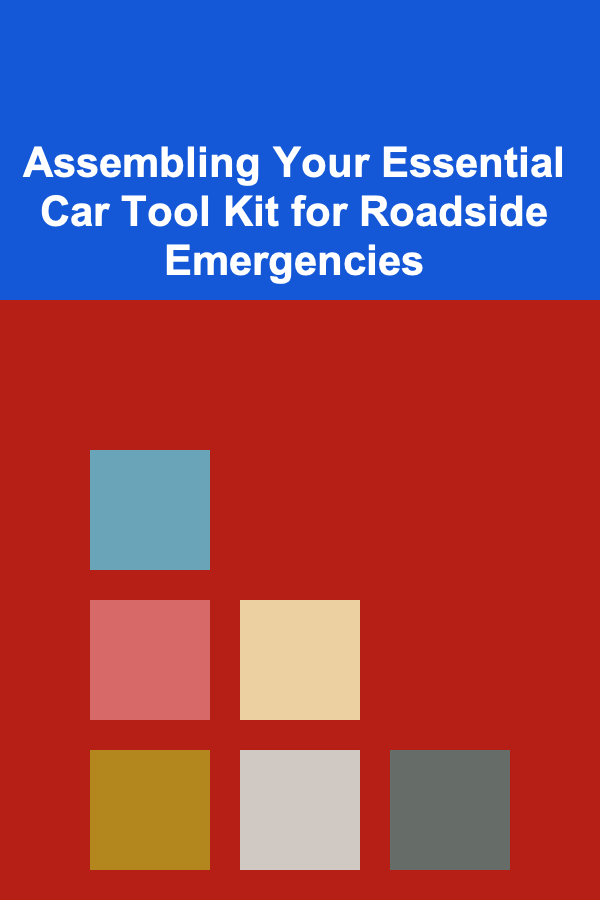
How to Organize Your Medicine Cabinet for Safety and Accessibility
ebook include PDF & Audio bundle (Micro Guide)
$12.99$7.99
Limited Time Offer! Order within the next:

Organizing your medicine cabinet is crucial for maintaining the safety and health of your household. A well-organized cabinet not only allows easy access to medications and health supplies but also ensures that you can quickly find what you need during emergencies. This comprehensive guide will explore how to organize your medicine cabinet effectively, focusing on safety, accessibility, and efficiency.
Understanding the Importance of a Well-Organized Medicine Cabinet
1. Easy Access in Emergencies
In times of medical emergencies, having a structured and organized medicine cabinet is vital. Quick access to medications or first aid supplies can make a significant difference in treatment outcomes.
2. Medication Safety
A disorganized cabinet increases the risk of medication errors, including taking outdated or incorrect medicines. Proper organization helps mitigate this risk by ensuring that only current and appropriate items are accessible.
3. Prevention of Accidental Ingestion
For households with children, an organized cabinet reduces the chances of accidental ingestion of harmful substances. Keeping dangerous items out of reach or locked away is essential for childproofing your home.
4. Maximizing Space
A cluttered cabinet wastes valuable storage space. Organizing your medicine cabinet allows you to maximize available space, making it easier to store additional items in the future.
5. Promotes Healthy Habits
An organized environment encourages healthy habits. When medications and health supplies are easily accessible, individuals are more likely to adhere to their prescribed routines.
Recognizing these benefits emphasizes the importance of organizing your medicine cabinet effectively.
Assessing Your Current Medicine Cabinet
Before diving into organization, assess your existing medicine cabinet:
1. Inventory Check
Take everything out of your medicine cabinet and create an inventory list. Note all medications, first aid supplies, vitamins, and other health-related items currently stored inside.
2. Expiration Dates
Check expiration dates on all medications and supplies. Dispose of anything that has expired, as using outdated products can be ineffective or even harmful.
3. Usage Frequency
Identify which items you use regularly and which ones are rarely accessed. This information helps prioritize what should be placed at eye level or within easy reach.
4. Identify Duplicates
Look for duplicate items or medications that can be reduced. Streamlining your collection can help reduce clutter significantly.
5. Evaluate Storage Conditions
Assess the conditions of your medicine cabinet. Ensure it's a cool, dry place, as heat and moisture can affect the efficacy of many medications.
This assessment provides a foundation for creating a safe and organized medicine cabinet.
Key Safety Considerations
Safety should be a top priority when organizing your medicine cabinet:
1. Childproofing
If you have young children, consider using cabinet locks or placing hazardous items in higher locations. Always keep medications in their original packaging with child-resistant caps.
2. Avoiding Heat and Moisture
Store medications in a climate-controlled environment. Bathrooms can be humid; consider moving items to a cooler, drier location if possible.
3. Secure Medications
Keep potentially dangerous medications, such as opioids or sedatives, locked away. This extra step can prevent misuse or accidental ingestion.
4. Familiarity with Medications
Ensure that all family members are familiar with the medications stored in the cabinet. Knowing where things are located can save time during emergencies.
5. Emergency Information
Keep emergency contacts and important health information inside your medicine cabinet, including allergies, chronic conditions, and emergency numbers.
Implementing these safety measures ensures a secure environment for all family members.
Essential Items to Include
When organizing your medicine cabinet, ensure you have the following essential items:
1. Over-the-Counter Medications
Stock up on common over-the-counter medications such as:
- Pain relievers (ibuprofen, acetaminophen)
- Cold and flu remedies
- Antihistamines
- Digestive aids (antacids, laxatives)
2. Prescription Medications
Include current prescription medications for all family members. Regularly review these to discard unused or expired medications.
3. First Aid Supplies
Essential first aid supplies should include:
- Adhesive bandages
- Gauze pads and tape
- Antiseptic wipes
- Antibiotic ointment
- Scissors and tweezers
4. Vitamins and Supplements
Store vitamins and supplements in a designated area. Keep in mind that some may have specific storage requirements.
5. Thermometers
Have a digital thermometer handy for quick temperature checks during illness.
6. Allergy Medications
Maintain an allergy kit that includes medications like antihistamines, nasal sprays, and inhalers for asthma suffers.
By stocking these essential items, you'll be prepared for most health-related situations.
Categorizing Medications and Supplies
Organizing your medicine cabinet requires categorization for optimal functionality:
1. By Type of Medication
Separate items based on their type:
- Pain Relief: Pain relievers and anti-inflammatory medications
- Cold and Allergy Relief: Cough syrups, antihistamines, decongestants
- Digestive Aids: Antacids, laxatives, probiotics
- First Aid Supplies: Band-aids, antiseptics, gauze
2. By Family Member
Consider categorizing items by family member:
- Create sections for each person's medications, making it easy to locate their essentials quickly.
3. By Purpose
Group products based on their purpose:
- Daily vitamins and supplements in one section
- Occasional use items like cold medications in another
4. Seasonal Items
Store seasonal items together, such as sunscreen and insect repellent during summer or flu medications during winter.
Effective categorization simplifies access to essential items and helps maintain order.
Storage Solutions for Organization
Choosing the right storage solutions can enhance the organization of your medicine cabinet:
1. Clear Bins
Use clear bins to group similar items together. Labels can help identify contents at a glance while keeping items organized.
2. Shelf Risers
Consider using shelf risers to maximize vertical space. This method allows you to stack items without losing visibility.
3. Drawer Organizers
If your cabinet has drawers, use drawer organizers to separate and categorize smaller items like band-aids, cotton swabs, and ointments.
4. Magnetic Strips
Install magnetic strips inside cabinet doors for small metal items, such as tweezers or scissors, keeping them accessible yet out of the way.
5. Labels
Label each bin or shelf clearly. Use a labeling system that works for your family, whether by category, family member, or purpose.
6. Hooks
If there's room, consider adding hooks for hanging items like small bottles or tools that may easily get lost.
These storage solutions can help you achieve an efficient and organized medicine cabinet.
Labeling Your Medicine Cabinet
Effective labeling promotes easy access and understanding of the organization system:
1. Choose a Labeling System
Decide on a labeling system---this could involve color coding, symbols, or clear text labels indicating the categories.
2. Use Durable Materials
Select durable labels that can withstand humidity and potential spills. Waterproof labels are an excellent option for bathroom environments.
3. Include Important Information
Labels can include expiration dates or any critical safety information, especially for medications requiring caution.
4. Place Labels Strategically
Attach labels on the front-facing side of bins for easy identification. If using shelves, label both the shelf and the category of items on it.
5. Update Regularly
As you reorganize or reorder items, make sure to update the labels accordingly. Consistency is key to maintaining an orderly cabinet.
Labeling enhances clarity and ensures everyone knows where to find and return items after use.
Regular Maintenance and Re-assessment
An organized medicine cabinet requires regular maintenance:
1. Schedule Routine Checks
Set a reminder to check your medicine cabinet every six months. During this time, reassess contents, remove expired medication, and reorganize as necessary.
2. Refresh Inventory
Make it a habit to refresh your inventory list during these checks. This practice keeps you informed about what needs replenishing.
3. Encourage Family Participation
Involve family members in the inspection process, teaching them the importance of maintaining an organized space.
4. Adjust as Necessary
Adapt your organization strategy as needed. If certain items are used more frequently, reorganize to make them more accessible.
5. Document Changes
Keep a record of items added or removed for accountability and ease of reference in the future.
Regular maintenance ensures that your medicine cabinet stays functional and safe over time.
Special Considerations for Families and Children
Families and households with young children have unique considerations when organizing their medicine cabinets:
1. Childproofing Measures
Invest in childproof cabinets or locks to secure medications and potentially hazardous items. Educate children about the dangers of medications.
2. Accessible Adult Items
Ensure that items intended for adult use, such as prescriptions, are kept out of children's reach but still easily accessible for responsible adults.
3. Role of Older Children
Teach older children about medication safety and encourage them to help maintain the organization system. They can learn responsibility and ensure their own items are managed well.
4. Emergency Plans
Create a plan for addressing accidental ingestion or misuse of medications. Keep emergency contact numbers visible in the cabinet.
5. Visual Aids
Consider using visuals or diagrams for younger children to understand which items are safe to touch and which are not.
By implementing these considerations, families can ensure better safety and organization within their medicine cabinet.
Conclusion
Organizing your medicine cabinet for safety and accessibility is a crucial task that pays dividends in health, efficiency, and peace of mind. By understanding the importance of organization, assessing your current setup, implementing safety measures, and utilizing effective storage solutions, you can create a functional space that serves your family's needs.
Regular maintenance and adaptation are essential to keeping your cabinet organized over time. With these strategies in place, you can confidently navigate your medicine cabinet, ensuring that you and your family are prepared for any health-related situation. Embrace the journey toward a safer, more organized home today!

How to Build a Checklist for Holiday Tree Decorating
Read More
How to Keep Your Home's Air Ducts Clean and Maintained
Read More
How to Use Color Coding for Your DIY Supplies
Read More
Building Functional Strength for Daily Activities: A Comprehensive Guide
Read More
Assembling Your Essential Car Tool Kit for Roadside Emergencies
Read More
How to Become a Savvy Shopper
Read MoreOther Products

How to Build a Checklist for Holiday Tree Decorating
Read More
How to Keep Your Home's Air Ducts Clean and Maintained
Read More
How to Use Color Coding for Your DIY Supplies
Read More
Building Functional Strength for Daily Activities: A Comprehensive Guide
Read More
Assembling Your Essential Car Tool Kit for Roadside Emergencies
Read More